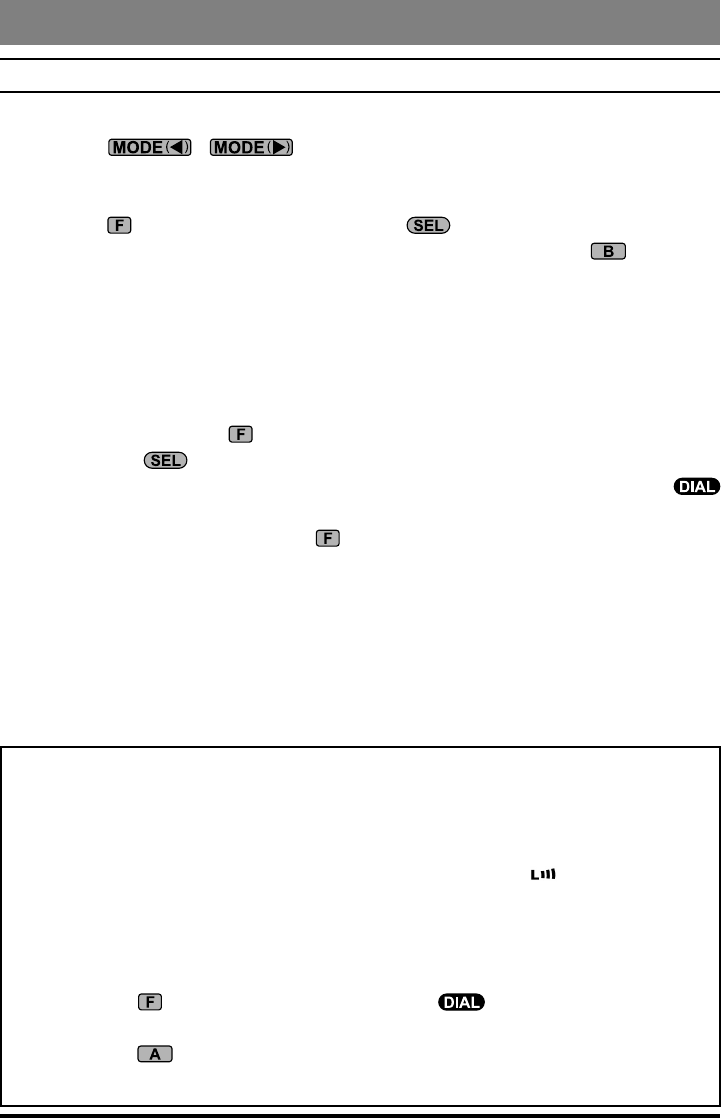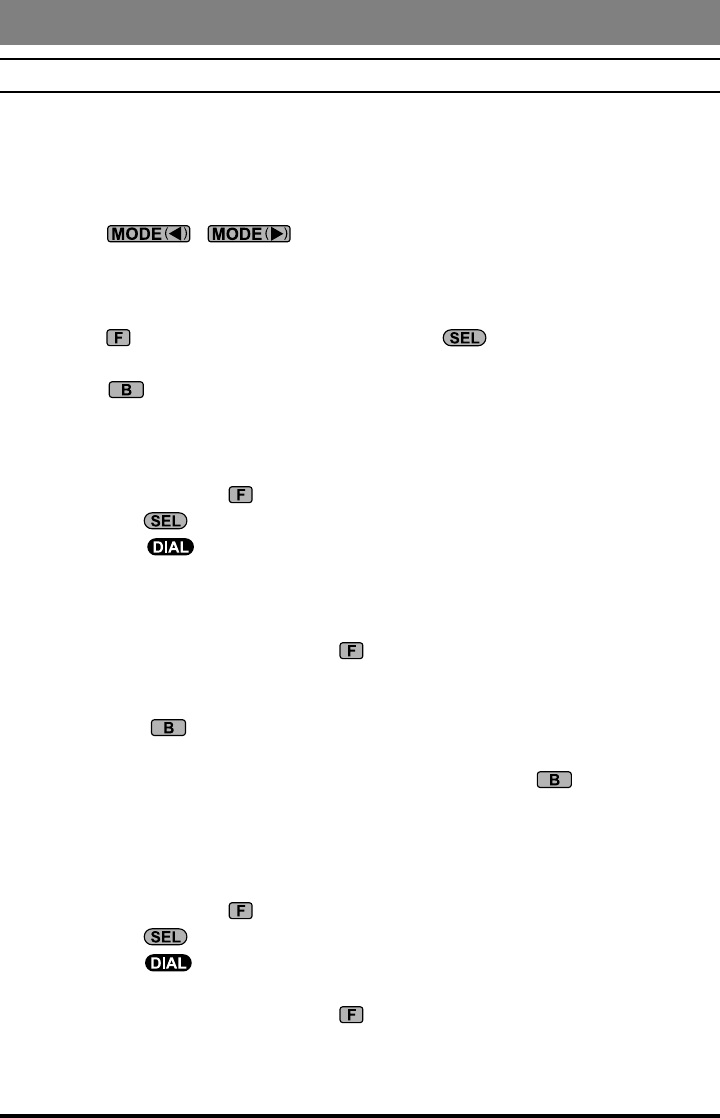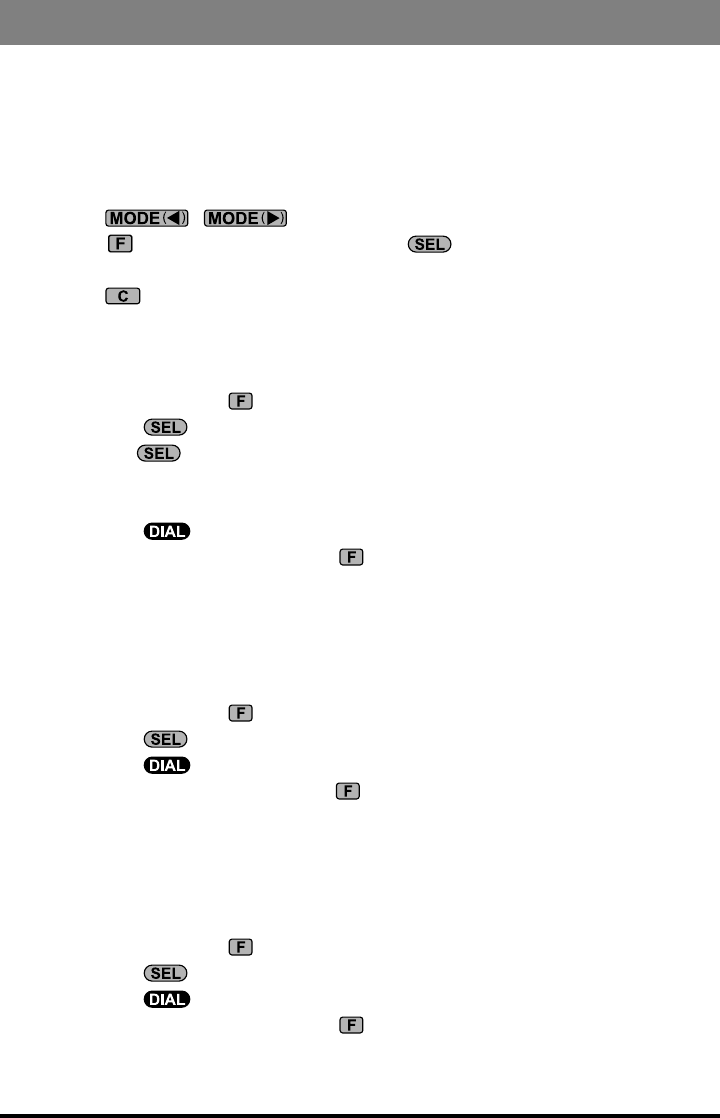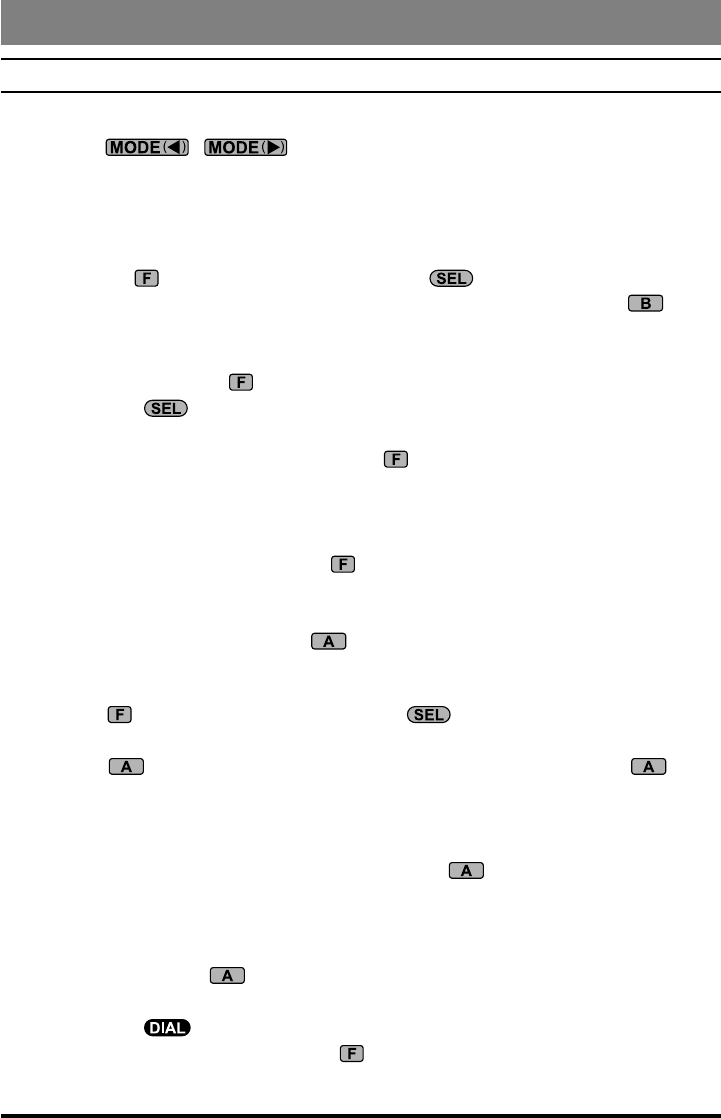Yaesu Musen 03770X30 HF/VHF/UHF TRANSCEIVER User Manual Operating Manual 3
Yaesu Musen Co., Ltd. HF/VHF/UHF TRANSCEIVER Operating Manual 3
Contents
Operating Manual-3

24 FT-818 Operating Manual
Receiver Accessories
att (FrOnt end attenuatOr)
The Attenuator will reduce all signals (and noise) by 10 dB, and it may be used to make
reception more pleasant under extremely noisy conditions. This feature is not available on
the 144 MHz and 430 MHz.
1. Press the key momentarily, then rotate the knob, as needed, until Operating
Function Row 7 [IPO, ATT, NAR] appears on the display.
2. Press the (ATT) key to activate the Attenuator. The “” icon will appear at the
right of the “ATT” indication.
3. Press the (ATT) key once more to switch the Attenuator out of the receiver front
end circuit.
aM/FM dial
In the AM and FM modes, the knob is locked out (via the setting of Menu #04) so
as to allow “channelized” tuning on these modes. To adjust the operating frequency, rotate
the knob.
If you wish to enable the knob for tuning in the AM and FM modes, change the set-
ting of Menu #04. See page 58 for details.
The “channelized” mode of tuning on AM and FM automatically rounds off the fre-
quency to the next “logical” step when you rotate the knob one “click” in either
direction. This eliminates the inconvenience of having to preset the frequency to an
“even” channel.

25FT-818 Operating Manual
Receiver Accessories
autOMatic pOwer-OFF Feature
The APO feature helps conserve battery life by automatically turning the transceiver off
after a user-dened period of time within which there has been no dial or key activity. The
available selections for the time before power-off are 1 ~ 6 hours, as well as “APO Off.”
The default condition for the APO is OFF, and here is the procedure for activating it:
1. Press and hold the key for one second to enter the Menu mode.
2. Rotate the knob to recall Menu #08 (APO TIME).
3. Rotate the knob to select the desired time period after which the radio will auto-
matically shut down.
4. Press and hold the key for one second to save the new setting and exit to normal
operation.
Once you have programmed a time interval, the APO countdown timer will start whenev-
er some front panel action (tuning, transmission, etc.) is completed.
When the APO is activated, the “ ” icon will appear at the center bottom on the LCD. If
there is no action by you within the time interval programmed, the microprocessor will
shut down the radio automatically.
Just press and hold in the switch for one second to turn the transceiver back on after
an APO shutdown, as usual.

26 FT-818 Operating Manual
SSb tranSMiSSiOn
Basic Setup/Operation
1. Press the / key so as to select either SSB (LSB/USB) mode. If
you are operating on the 7 MHz or lower bands, select the LSB mode. If you are oper-
ating on the 14 MHz or higher bands, select the USB mode.
2. Press the key momentarily, then rotate the knob, as needed, until Operating
Function Row 9 [PWR, MTR] appears on the display, then press the (MTR) key
to select the “ALC” meter function (“alc” will appear at the right side of the “MTR” icon).
3. Press the microphone’s PTT switch, and speak into the microphone in a normal voice
while watching the meter. The ideal audio input level to the transmitter from the mi-
crophone will cause a few “segments” of indication on the ALC meter. Release the
PTT switch to return to receive mode.
4. If the ALC meter is too high, or too low, you may need to reset the Microphone Gain:
Press and hold in the key for one second to enter the Menu mode.
Rotate the knob to recall Menu #46 (SSB MIC).
Close the PTT switch, and while speaking into the microphone rotate the
knob until the proper ALC indication is achieved on voice peaks.
When done, press and hold in the key to save the new setting for the Microphone
Gain.
The [TONE] switch on the back of the MH-31A8J microphone provides adjustment of
the microphone’s frequency response. Setting this switch to the “2” position will roll
off some of the bass response, resulting in improved “talk power” in many instances.
The “1” position is primarily used in countries like Japan, where vowel sounds are of
critical importance in conveying information; in Western languages, consonant sounds
(which are rich in high-frequency components) are frequently more important.
Adjusting the Transmitter Power Output
Four power levels are available on the FT-818: 6 Watts, 5 Watts, 2.5 Watt, and 1.0
Watt. When using Alkaline batteries or the supplied SBR-32MH Ni-MH Battery
Pack, the microprocessor, detecting internal battery use, automatically sets the
power level to 2.5 Watts, which appears on the display as “ ”. If you set the
power to ve watts, the power level icon is the same as for 2.5 Watt operation, but
at 6 Watts the icon is blinking. For 0.5 Watt, there is one “bar” to the right of the “L”
in the power icon, and for 1 Watt there are two “bars” displayed.
The power level is easy to change:
1. Press the key momentarily, then rotate the knob to select Operating
Function Row 9 [PWR, MTR].
2. Press the (PWR) key, as needed, to set the desired power level. The icon
will change, based on the power level you have set.
Transmitter Operation

27FT-818 Operating Manual
Transmitter Operation
VOX Operation
The VOX system provides automatic transmit/receive switching based on voice input to
the microphone. With the VOX system enabled, you do not need to press the PTT switch
in order to transmit.
1. Press the key momentarily, then rotate the knob, as needed, until Operating
Function Row 10 [VOX, BK, KYR] appears on the display.
2. Press the (VOX) key to activate the VOX circuitry. The “” icon will appear at
the right of the “VOX” indication.
3. Without pressing the PTT switch, speak into the microphone in a normal voice level.
When you start speaking, the transmitter should be activated automatically. When you
nish speaking, the transceiver should return to the receive mode (after a short delay).
4. To cancel VOX and return to PTT operation., again press the (VOX) key. The “”
icon will disappear.
5. The VOX Gain may be adjusted, so as to prevent accidental transmitter activation in a
noisy environment. To adjust the VOX Gain:
While still in Operating Row 10 [VOX, BK, KYR], press and hold in the (VOX)
key for one second. This is a “hot key” feature which will instantly recall Menu
#51 (VOX GAIN).
While speaking into the microphone, rotate the knob to the point where the
transmitter is quickly activated by your voice, without causing background noise
to activate the transmitter.
When you have selected the optimum setting, press and hold the key for one
second to save the new settings and return to normal operation.
6. The “Hang-Time” of the VOX system (the transmit-receive delay after the cessation
of speech) may also be adjusted via the Menu. The default delay is 1/2 second. To set
a different delay time:
Press and hold in the key for one second to activate the Menu mode.
Rotate the knob to select Menu #50 (VOX DELAY).
Rotate the knob while saying a brief syllable like “Ah” so as to set the de-
sired delay time.
When your adjustments are complete, press and hold in the key for one second
to save the new setting and return to normal operation.
The delay time for return to the receive mode is set independently on CW and voice
modes; for CW, use Menu #17 (see next section).

28 FT-818 Operating Manual
Transmitter Operation
cw tranSMiSSiOn
Operation using Straight Key/External Keying Device
When using a straight key, an external electronic keyer, or a computer-generated keying
device, please follow the instructions in this section.
1. Insert your key’s (three-conductor) plug into the rear-panel KEY jack.
2. Press the / key, as needed, to select one of the CW (CW/CWR)
modes.
The “CW” mode utilizes USB-side carrier injection, while the CWR (Reverse) mode
utilizes LSB-side injection.
3. Press the key momentarily, then then rotate the knob, as needed, until Oper-
ating Function Row 10 [VOX, BK, KYR] appears on the display.
4. Press the (BK) key, as needed, to activate “Semi Break-In” operation. The “”
icon will appear at the right of the “BK” indication.
5. The CW hang time can be adjusted using Menu #17 (CW DELAY). To adjust the CW
hang time:
Press and hold in the key for one second to enter the Menu mode.
Rotate the knob to select Menu #17 (CW DELAY).
Rotate the knob to select a longer or shorter delay time (default: 250 ms).
This transceiver was not expressly designed for “full QSK” operation, the min-
imum (10 ms) setting of this Menu item (CW DELAY) will be very close to full
break-in performance.
When done, press and hold in the key for one second to save the new setting
and exit to normal operation.
If you are already in Operating Function Row 10 [VOX, BK, KYR], pressing and
holding in the (BK) key for one second will instantly select Menu #17 (CW DE-
LAY).
6. To practice your CW sending (without transmitting), press the (BK) key to make
the “” icon disappear. Now, pressing the key will cause the CW sidetone to be
heard, but your radio will not be transmitting a signal on the air.
7. You can adjust the CW sidetone volume level via Menu #44 (SIDETONE). To adjust
the CW sidetone volume level:
Press and hold in the key for one second to enter the Menu mode.
Rotate the knob to select Menu #44 (SIDETONE).
Rotate the knob to select a new level; on the arbitrary scale of “0” ~ “100,”
the default value is “50.”
When done, press and hold in the key for one second to save the new setting
and exit to normal operation.

29FT-818 Operating Manual
Transmitter Operation
8. You also can adjust the CW sidetone pitch using Menu #20 (CW PITCH). This adjust-
ment also controls the BFO offset (actual pitch of your transmitted signal relative to
your current receive frequency). To adjust the CW sidetone pitch:
Press and hold in the key for one second to enter the Menu mode.
Rotate the knob to select Menu #20 (CW PITCH).
Rotate the knob to select a new pitch tone/BFO offset. The available offset
range is 300 ~ 1000 Hz (default value is “700 Hz”).
When done, press and hold in the key for one second to save the new setting
and exit to normal operation.
Because the CW Pitch corresponds to the actual pitch of your transmitted signal, the si-
detone may be used in a “CW Spot” capacity. Just tune the pitch of the received signal
to the same pitch as that of your transceiver’s sidetone, and you will be perfectly “zero
beat” with the other station.
The FT-818 can generate a “CW Spot” tone; just press and hold in the key while
in the CW mode.

30 FT-818 Operating Manual
Transmitter Operation
Operation using Built-in Electronic Keyer
The built-in Electronic Keyer provides a convenient method of generating CW. The Elec-
tronic Keyer includes weight and speed adjustments.
1. Connect your keyer paddle’s cable to the KEY jack on the rear panel of the transceiv-
er.
2. Press the / key, as needed, to select the CW (CW/CWR) mode.
3. Press the key momentarily, then rotate the knob, as needed, until Operating
Function Row 10 [VOX, BK, KYR] appears on the display.
4. Press the (KYR) key to activate the Electronic Keyer. The “” icon will appear at
the right of the “KYR” indication.
5. The Keyer speed may be adjusted using Menu #21 (CW SPEED). To adjust the Keyer
speed:
Press and hold in the key for one second to enter the Menu mode.
Rotate the knob to select Menu #21 (CW SPEED).
Press the knob if you wish to select display of “cpm” (characters per min-
ute) instead of “wpm” (words per minute). The “cpm” selection is based on the
international “PARIS” standard, which stipulates ve characters per word.
Rotate the knob, while sending, to set the desired sending speed.
When done, press and hold in the key for one second to save the new setting
and exit to normal operation.
If you are already using Operating Function Row 10 [VOX, BK, KYR], press and
hold in the [C](KYR) key to switch instantly to Menu #21 (CW SPEED).
6. The Dot:Dash weighting ratio may be adjusted via Menu #22 (CW WEIGHT). To ad-
just the Dot:Dash weighting ratio:
Press and hold in the key for one second to enter the Menu mode.
Rotate the knob to select Menu #22 (CW WEIGHT).
Rotate the knob to set the desired weight.
When done, press and hold in the key for one second to save the new setting
and exit to normal operation.
7. You may select “normal” or “reverse” paddle polarity via Menu #19 (CW PADDLE).
The default setting for this feature is “normal,” whereby the “Tip” connection on the
Key Plug is “Dot” and the “Ring” connection is “Dash.” To change the paddle polari-
ty:
Press and hold in the key for one second to enter the Menu mode.
Rotate the knob to select Menu #19 (CW PADDLE).
Rotate the knob to select the new setting.
When done, press and hold in the key for one second to save the new setting
and exit to normal operation.

31FT-818 Operating Manual
Transmitter Operation
FM tranSMiSSiOn
Basic Setup/Operation
1. Press the / key so as to select the FM mode.
2. Press the microphone’s PTT switch, and speak into the microphone in a normal voice.
3. Release the PTT switch to return to the receive mode.
4. If you get reports that your modulation level is too high or too low, you may need to
adjust the FM-mode microphone gain. The procedure is similar to that used on SSB:
Press the key momentarily, then rotate the knob, as needed, until Operat-
ing Function Row 9 [PWR, MTR] appears on the display, then press the (MTR)
key to select the “Deviation” meter function (“mod” will appear at the right side
of the “MTR” icon).
Press and hold in the key for one second to enter the Menu mode.
Rotate the knob to recall Menu #29 (FM MIC).
Increase or decrease the setting of the FM Mic Gain, depending on the level cor-
rection required, then press and hold the key to save the new setting.
Close the PTT switch, and while speaking into the microphone observe the meter
indication; the proper setting of the FM Mic Gain will produce ve “bars” of indi-
cation on voice peaks, slightly less on lower levels of speech input.
When done, press and hold in the key to save the new setting for the FM-mode
microphone gain.
5. The VOX feature is operational during FM transmission. From Operating Function
Row 10 [VOX, BK, KYR], press the (VOX) key to activate/deactivate VOX.
Repeater Operation
1. Press the key momentarily, then rotate the knob, as needed, until Operating
Function Row 4 [RPT, REV, TON] appears on the display.
2. Press the (RPT) key to activate repeater operation. One press of the (RPT)
key will have set the transceiver for “Minus Shift” operation. In this situation, you
will observe the “–” indicator on the display. The transmitter frequency will be shifted
down by a default value so as to access the repeater input frequency. If your repeater
uses a positive shift (instead of negative), press the (RPT) key again; the “+” in-
dicator will replace the “–” indicator on the display.
3. If the default repeater shift is not appropriate for your area, it may be set independent-
ly for each band. To change the repeater shifts:
Press and hold the (RPT) key for one second. This instantly recalls Menu #42
(RPT SHFT).
Rotate the knob to select the desired shift frequency.
When done, press and hold in the key for one second to save the new setting
and exit to normal operation.